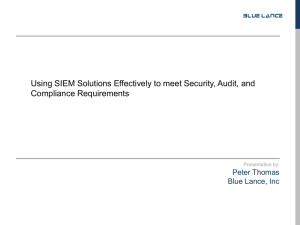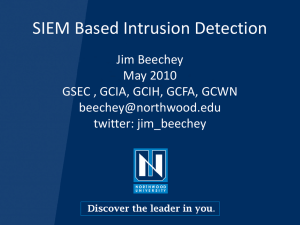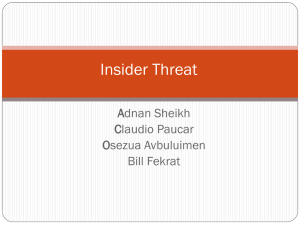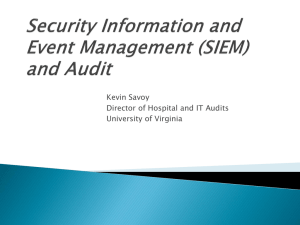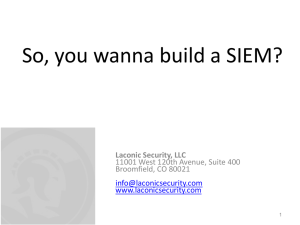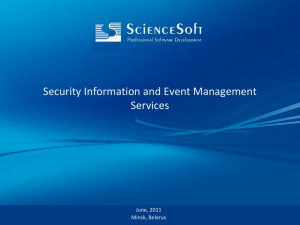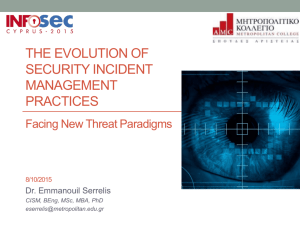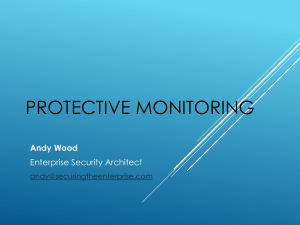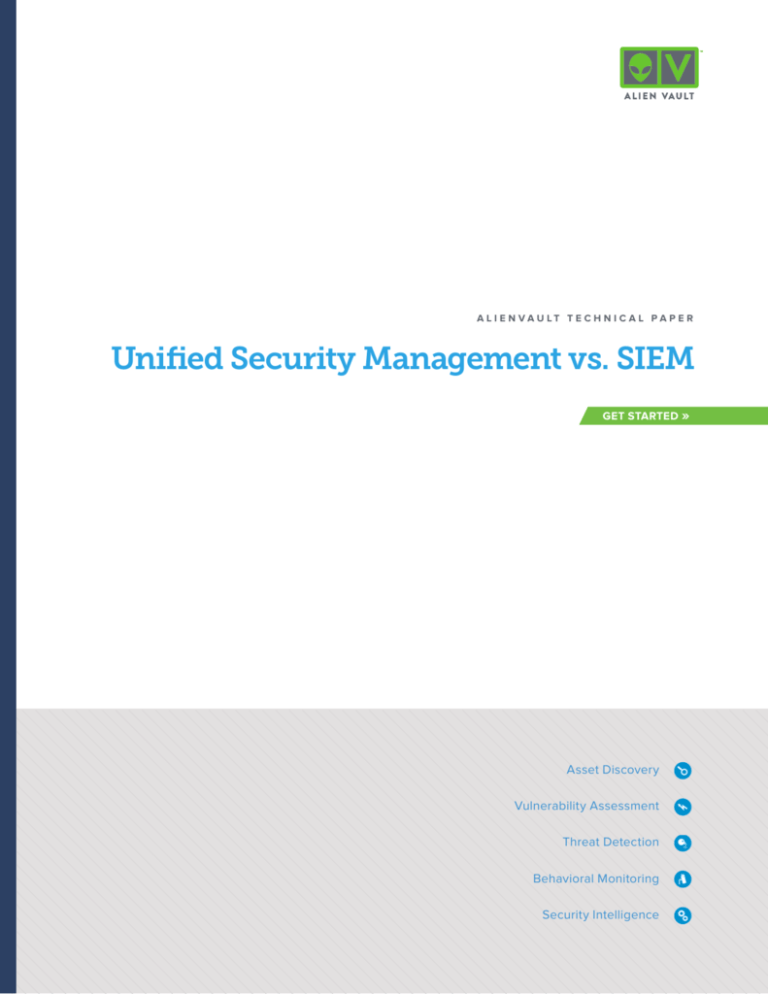
A L I E N VA U LT T E C H N I C A L PA P E R
Unified Security Management vs. SIEM
GET STARTED »
Asset Discovery
Vulnerability Assessment
Threat Detection
Behavioral Monitoring
Security Intelligence
A L I E N VA U LT T E C H N I C A L PA P E R
Unified Security Management vs. SIEM
The purpose of this document is to provide an overview of the changing security landscape, and
more importantly to provide insight into the rapidly changing SIEM category, and the reasons that
have led to those changes. To offer a complete picture of the changes to SIEM technology, it is
valuable for some customers to understand the context of the SIEM market and how (and why)
AlienVault differentiates itself from this traditional approach.
ABOUT ALIENVAULT
The History of “SEM, SIM or SIEM?”
Founded: 2007
To best describe the market today, it’s helpful to first revisit how the market has evolved.
HQ Global: San Mateo, CA
HQ EMEA/APAC: Ireland
Ownership: Privately held
Initially Security Event Management (SEM) tools were designed for threat management
against a noisy external threat environment that consisted primarily of worms. The
orientation of SEM tools was primarily network and system events combined with
real-time analysis to support incident response. There were also Security Information
Management (SIM) vendors that provided long-term storage of log files, historical
analysis and trending against a large database of data to support forensic activities.
So we had real-time analysis to support incident response and long-term storage and
historical analysis to support trend reporting and forensics.
Security Information and Event Management (SIEM) emerged as companies found
themselves spending a lot of money on intrusion detection/prevention systems (IDS/
IPS). These systems were helpful in detecting external attacks, but because of their
reliance on signature-based detection, they generated a large number of false positives.
First-generation SIEM technology was designed to reduce this signal-to-noise ratio
and helped to capture the most critical external threats. Using rule-based correlation,
SIEM helped IT teams detect real attacks by focusing on a subset of firewall and IDS/
IPS events that were in violation of policy. Although expensive and time-intensive to
maintain and tweak, SIEM investments continued as they solved a big headache of
sorting through excessive false positives and effectively protecting companies from
external threats.
While SIEM was a step in the right direction towards improved management, the world
got more complicated when new regulations such as the Sarbanes-Oxley Act (SOX)
and the Payment Card Industry Data Security Standard (PCI DSS) required much stricter
internal IT controls and assessment. Virtualization became more prevalent as well, and
new security point solutions were introduced as the explosion of personal devices
entered the enterprise.
A L I E N VA U LT T E C H N I C A L PA P E R
Unified Security Management vs. SIEM
To satisfy these new requirements, organizations were required to collect, analyze,
report on and archive all logs to monitor activities inside their IT infrastructures. The
intent was not only to detect external threats, but also to provide periodic reports of
user activities and create forensics reports surrounding a given incident. Though SIEM
Log management
tools were designed
to collect, report,
and archive a large
volume and breadth
of log data, whereas
SIEM solutions were
designed to correlate
a subset of log data
technologies collected logs, they processed only a subset of data related to security
breaches. They weren’t designed to handle the sheer volume of log data generated
from all IT components, such as applications, switches, routers, databases, firewalls,
operating systems, IDS/IPS and Web proxies.
Created to monitor user activities rather than external threats, Log Management (LEM)
products entered the market as a technology with an architecture to handle much
larger volumes of data and with the ability to scale to meet the demands of the largest
enterprises. Although companies implemented log management and SIEM solutions to
satisfy different business requirements, they also discovered that the two technologies
work well together. Log management tools were designed to collect, report, and archive
a large volume and breadth of log data, whereas SIEM solutions were designed to
correlate a subset of log data to point out the most critical security events, and that
hasn’t changed. Splunk, for example, is a log management solution with a very small
security use case. SIEM solutions continue to focus on aggregating ‘external’ data
sources.
Unfortunately, both LEM and SIEM lack the security intelligence needed to detect
threats and effectively combat today’s attacks. To make matters worse, in tough
economic times or tight budgets influencing decisions, we can expect to see IT trying to
stretch its legacy logging technologies to solve even more problems (as demonstrated
by the convergence of SEM and SIM, which created SIEM). Now we’ve caught you up,
let’s talk about “What’s Changed?” and “Why?”
“What’s Wrong with SIEM?”
Fast-forward a decade—today we have many IT security teams that have made a
significant investment in both money and resources (people) to support traditional SIEM
products, only for the SIEM to show little-to-no material value on delivering on the
promise of security visibility. The reasons for these shortfalls are numerous.
It’s important to note that the risk that organizations feel is real, just as the threats are
very real. As illustrated in Figure 1, the reality is that the “actual” threat is usually much
greater than the “perceived” threat inside of most organizations.
The dirty little secret in the SIEM industry is that most SIEM solutions have a shelf life of
approximately 18-24 months before organizations give up and begin to look for another
SIEM solution. Most organizations cannot support these deployments and many SIEM
technologies fail not due to technology failures but because organizations simply don’t
have the time, money, resources or process to support the technology. It’s the inability
of organizations to Implement and Tune the technology and not the SIEM solution
© 2014 AlienVault. All rights reserved.
Page 3
A L I E N VA U LT T E C H N I C A L PA P E R
Unified Security Management vs. SIEM
itself that threatens the long-term value of traditional SIEM. In other words, the entire
category of SIEM is flawed in its approach, especially in the mid-market where resources
are often hard to come by. Let’s examine the specific areas that lead to these failures:
Poor Correlation
It is difficult to strike the right balance between correlation rules that catch all possible
attacks and correlation rules that produce too many false-positive alerts. Tuning often
requires a professional services engagement and on-going expenses, and industry
analysts report speaking with customers for whom, “...a year of tuning was required”. This
lack of balance will continue to plague the SIEM vendors as the complexity of managing
all of the changes in a typical network, including moves, adds, and edits to the data
sources (such as servers, devices, and applications) is not something they can solve.
Organizations rely on the data collection, normalization and retention capabilities of
the SIEM for the purpose of correlation. Without very strong (i.e. custom) correlation,
detecting and responding to threats is impossible. And, if an organization wants to
ensure the fidelity of their correlation logic, it must verify its custom correlation every
time there is a change on the network. For example, it’s not uncommon to see a routine
update to a data source (for example, due to an OS/firmware update) dramatically
impact the fidelity of the correlation rules/alarms/logic. This happens when updates are
performed to network devices, servers (physical and virtual), antimalware, applications,
and so forth. Organizations are very dynamic, and the network infrastructure is always
evolving.
Ease of Use
As stated before, SIEM solutions have been around for almost a decade. These same
solutions were built to serve the largest of enterprises where resources and “dedicated”
headcount are more the norm. Understanding “whom” these solutions were designed
to serve, the vast majority of SIEM solutions are very difficult to use. Sadly, security pros
have resigned themselves to accept this as just another part of the job. But that doesn’t
have to the case.
Trending and analytics
If the tuning/correlation doesn’t get you the failure, then consumable analytics will.
SIEMs often have a selection of canned reports but new report creation is not flexible
to adjust to rapidly changing conditions in today’s environments. Canned reports can
be useful, and may look great initially, but relying on a canned report to understand
the end-to-end implications of a security event from the edge router to the application
simply doesn’t work. In a world where threats are increasingly dynamic, reporting must
also be dynamic.
The “Rules-based” approach
When a correlated security event is presented to the security analyst, it’s reasonable to
expect the analyst to limit his or her investigation to the data sources reported by the
alert. A “Rules-based” approach supports only a go-forward view of security data—if
© 2014 AlienVault. All rights reserved.
Page 4
A L I E N VA U LT T E C H N I C A L PA P E R
Unified Security Management vs. SIEM
you get a correlation rule wrong, you can’t adjust the model and re-analyze the data,
because events that didn’t match the old rule have already been discarded. Not the
desired outcome, and certainly not for what these traditional SIEM solutions cost.
Cost
SIEM is expensive. It’s expensive because large enterprise organizations continue to
pay hefty prices for these solutions. SIEM has, in most cases, been cost-prohibitive for
the mid-market customer who is looking to secure their organization. Costs associated
with a traditional SIEM deployment include:
Initial Licensing Costs
››
Implementation/Optimization Costs
››
Ongoing Management Costs
››
Renewal Costs
››
Integration of data sources from disparate security technologies
››
Training of personnel/incoming personnel
››
The hidden costs are what usually result in the demise of the traditional SIEM
deployment—the very real and painful costs associated to deploying, integrating, using,
managing, training, tuning, cursing, and potentially expanding the deployment.
These are the areas that have led to such dissatisfaction with the traditional SIEM
approach. These are very real and evident in almost every organization that has had
experience with SIEM. AlienVault only had to listen to its customers to know that
something had to change. This was the primary driver in introducing the Unified Security
Management (USM) platform.
Gartner Magic Quadrant for SIEM
— 2014
“What Options Does My Organization Have Besides SIEM?”
Despite the Billions (with a “B”) being spent every year on security, these things hold true:
More and more organizations are finding themselves in the crosshairs of various
››
bad actors for a variety of reasons, most often to steal customer data or IP, or smear
a reputation.
The “security arms race” cannot continue indefinitely as the economics of securing
››
your organization is stacked so heavily in favor of those launching the attacks that
incremental security investments are seen as impractical.
In spite of SIEM technology being on the market for several years, it continues to
››
disappoint users.
Fortunately, there is an alternative to traditional SIEM, one that overcomes the
© 2014 AlienVault. All rights reserved.
Page 5
A L I E N VA U LT T E C H N I C A L PA P E R
Unified Security Management vs. SIEM
challenges that continue to limit the effectiveness of SIEM technology: Poor Correlation,
Ease of Use, Trending and Analytics, Rules-Based Approach, and High cost—Unified
Security Management, or USM.
Unlike any other security solution on the market, AlienVault’s USM platform has
dramatically reduced the cost and complexity related to buying and deploying all of the
essential security controls required for comprehensive security visibility.
Gartner recognizes that there is only one vendor in the SIEM category that is seen as a
“Visionary”. AlienVault is fundamentally changing the way threat detection and incident
response is done taking into consideration the last decade of lessons and building a
solution that will finally address the lack of security visibility organizations have today.
The Alternative: Unified Security Management
IT organizations of all shapes and sizes have embraced USM to reduce the cost, improve
security visibility and accelerate threat detection and remediation. They need access
to security solutions that offer significant time-to-value returns, while improving their
overall security posture.
At AlienVault we’re committed to unifying best-of-breed
USM delivers integrated security controls to simplify and
technology with shared global threat intelligence for truly
accelerate threat detection and remediation
open and collaborative security.
AlienVault’s Unified Security Management™ (USM) platform
gives organizations a solution that offers an effective
alternative to the most sophisticated and expensive
enterprise-level security products.
AlienVault has included five essential security capabilities
managed by a single console, providing everything you
need for complete security visibility and threat intelligence.
These capabilities include Asset Discovery, Vulnerability
Assessment, Threat Detection, Behavioral Analysis, and
Security Intelligence. These integrated features are powered
by up-to-the-minute threat intelligence from AlienVault Labs
and our Open Threat Exchange™—the world’s largest crowdsourced collaborative threat repository.
AlienVault offers the only Unified Security Management solution to unify these five
essential security capabilities. With essential security controls built-in, AlienVault USM
puts complete security visibility within fast and easy reach, which translates into rapid
time to value. Whether large or small, all organizations need the complete visibility USM
offers to:
Detect emerging threats across your environment
››
© 2014 AlienVault. All rights reserved.
Page 6
A L I E N VA U LT T E C H N I C A L PA P E R
Unified Security Management vs. SIEM
Respond quickly to incidents and conduct thorough investigations
››
Measure, manage, and report on compliance (PCI, HIPAA, ISO, and more)
››
Optimize your existing security investments and reduce risk
››
USM also offers simplicity, streamlined installation and use, and the ability to update
all the security functions concurrently. These concurrent updates allow AlienVault to
do something no other solution on the market can do—AlienVault Labs threat research
team can write, maintain and verify all the needed correlation delivering the highest
levels of security visibility.
AlienVault believes to simplify security, you must simplify the solutions designed to
deliver security visibility. AlienVault is fanatical about putting users first in everything we
do. We strive every day to deliver powerful functionality that is easy to use with one of
the fastest and longest lasting ROIs in the market.
AlienVault Labs Threat Intelligence and Open Threat Exchange
One of major challenges smaller IT organizations have is being able to conduct the
research needed to keep up with the constant evolution of the threat landscape.
Fortunately, you have AlienVault on your side.
Think of our
Labs team as an
extension to your
IT team
Think of our Labs team as an extension to your IT team. AlienVault understands that
threat experts are very difficult to find. It’s an enormous financial commitment to have
threat experts dedicated to researching the latest threats and how to detect them, as
well as being constantly engaged in dialogue with other threat experts around the
trends that are being observed in the market.
The AlienVault Labs Threat Intelligence team maximizes the efficiency of your securitymonitoring program, by delivering the following directly to your AlienVault Unified
Security Management (USM) installation. This team of security experts delivers updates
to the product every 30 minutes that include 8 coordinated rule-sets that unify your
entire technology stack:
Network-based and Host-based IDS signatures — which detect the latest threats in
››
your environment.
Asset discovery and inventory database updates — identifies the latest operating
››
systems, applications and device types
Vulnerability database updates — dual database coverage to find the latest
››
vulnerabilities on all your systems
Report modules and templates — providing new ways to view data in your
››
environment
Incident response templates / “how to” guidance for each alarm in USM
››
© 2014 AlienVault. All rights reserved.
Page 7
A L I E N VA U LT T E C H N I C A L PA P E R
Unified Security Management vs. SIEM
Event Correlation
Another area where AlienVault’s integrated, security-focused design has an advantage
over other tools is event correlation. AlienVault understands that most organizations
don’t have the time, resources or expertise in-house to monitor changes to the
threat landscape as well as manage all the technologies they have deployed in their
environment.
AlienVault delivers actionable security intelligence by automating the event correlation
process:
Data Collection — Identify log data for automatic import and integration, from both
››
the technologies included in the USM platform and third party tools via plug-ins
−− Customers can utilize our extensive library of plug-ins or create their own for
custom applications and legacy devices
Normalization — Parse, normalize, and integrate log data into built-in SIEM analysis
››
engine
Cross Correlation — Apply 1,700+ correlation rules to asset, vulnerability, network
››
traffic, and threat data
Alarms & How to Respond — Assess severity, with detailed context-specific
››
remediation instructions
Emerging Threat Detection — Automatic updates of new correlation rules and
››
signatures for new threats, assets, vulnerabilities, and more
Traditional SIEM solutions would leave all this work
Integrated Management and Security Intelligence
up to you to perform. In other words, you would be
responsible for the SIEMs ability to detect threats —
you would need to write the correlation rules, do the
research, integrate threat feeds, etc. If your team is
putting out other fires or you fundamentally believe
that you should be leveraging the investments made at
monitoring your environment instead of managing your
SIEM; USM is the right solution for you.
AlienVault understands that most organizations don’t
have the time, resources or expertise (in some cases)
in house to develop, manage and monitor all of these
areas of their environment. With this easily consumable
threat intelligence fueling your USM platform, you’ll be
able to detect the latest threats and prioritize your response efforts. Specifically, you’ll
extend your security program with:
Real-time botnet detection — identifies infection and misuse of corporate assets
››
Data exfiltration detection — prevents leakage of sensitive and proprietary data
››
© 2014 AlienVault. All rights reserved.
Page 8
A L I E N VA U LT T E C H N I C A L PA P E R
Unified Security Management vs. SIEM
Command-and-control traffic (C&C) identification — identifies compromised
››
systems communicating with malicious actors IP, URL, and domain reputation data — prioritizes response efforts by identifying
››
known bad actors and infected sites
APT (Advanced Persistent Threat) detection — detects targeted attacks often
››
missed by other defenses
Dynamic incident response and investigation guidance — provides customized
››
instructions on how to respond and investigate each alert
Open Threat Exchange
Adding to the difficult is that the adversary is doing something that company security
teams are not doing—actively collaborating. The industry’s inability to share information
about attack vectors gives the adversary an advantage. Most threat intelligence
networks are closed and limited to only certain industries, vendors, or government
agencies. For the first time, AlienVault’s OTX enables anonymous sharing of threat
intelligence with anyone who joins.
OTX is an element of AlienVault’s USM platform’s security intelligence capability. OTX
is a framework for a unique and powerful collaborative defense capability that the
AlienVault Labs threat research team validates and curates. It incorporates a data from
This data is
automatically
cleansed, aggregated,
validated, curated
and published by the
Alienvault Labs threat
research team
more than 140 countries and a broad range of devices (firewalls, proxies, web servers,
anti-virus systems, and intrusion detection/prevention systems).
This data is automatically cleansed, aggregated, validated, curated and published by
the Alienvault Labs threat research team. In addition to providing data for the regular
updates of the USM platform, OTX enables collaborative security intelligence to spread
among many industries and countries, composed of organizations of all sizes. This
sharing limits the attacker’s ability to isolate targets by industry or organization size,
improving the security of anyone who participates.
AlienVault Capabilities Matrix
CAPABILITY
ALIENVAULT
Asset Discovery — Discover and track hosts, services, and installed software present
in the environment for improved correlation and context for incident response
ü
Vulnerability Assessment — identify vulnerabilities in the monitored environment
and track historical record for compliance purposes
ü
Threat Detection — monitor the environment for threats, identifying known attack
vectors, attack patterns, payload signatures and behavioral identification of exploits
and malware.
ü
Behavioral Monitoring — monitor the ongoing behavior of observed systems to
provide context for forensic investigation and identification of potential security
incidents
ü
Security Intelligence — aggregate and analyze information from all the security
controls and environment in order to correlate disparate behavior and provide a
platform for forensic investigation.
ü
© 2014 AlienVault. All rights reserved.
SIEM
ü
Page 9
A L I E N VA U LT T E C H N I C A L PA P E R
Unified Security Management vs. SIEM
Threat Intelligence — emerging threat analysis and research, which leverages more
than 8,000 global collection points across more than 140 countries to analyze over
500,000 malware samples and over 100,000 malicious IP addresses daily within the
world’s largest crowd-sourced threat intelligence exchange—Open Threat Exchange
(OTX)
TECHNOLOGY
ü
ALIENVAULT
Passive Network Discovery — identify hosts with passive network monitoring
Active Network Scanning — actively scan the network to identify and version
running services without local access to the machine
ü
ü
Host-based Software Inventory — provide full binary-level inventory of software
packages running on assets
ü
Continuous Vulnerability Monitoring — using data from the asset discovery
capabilities, correlate the latest known vulnerability feeds with the existing asset
inventory information to identify vulnerable services without active scanning
ü
Active Network Scanning — actively scan the network to identify vulnerable
services. Both authenticated and unauthenticated scanning is available depending
on the target.
ü
Network IDS — perform deep-packet inspection of the network traffic in order to
identify attacks, behaviors of compromised systems, policy violations, and more.
ü
Host IDS — monitor the operating system level activity of a host to identify
indicators of compromise, such as rootkits, malware, or abuse of system services
ü
File Integrity Monitoring — monitor changes to critical files to identify potential
security issues on critical hosts.
ü
Wireless IDS — monitor environments for rogue access points to identify
potentially unauthorized access to networks.
ü
Netflow Analysis — identify network activity throughout your environment.
Identifies protocol usage, and volume of traffic between hosts in monitored
environments.
ü
Service Availability Monitoring — identify service availability in the environment
to detect disruptions in availability, which could indicate a successful attack or
compromise.
ü
Log Management — provides a consolidated interface for reporting and querying
activity occurring in the monitored environments. Critical for most compliance use
cases.
ü
SIEM
ü
More About Alienvault
Don’t take our word for it — see what your peers and industry experts are saying:
GARTNER MQ
»
CUSTOMER STORIES
»
FREE TRIAL
»
WATCH A DEMO
»
At AlienVault, we believe that open and collaborative is the best way for all companies
to gain the security visibility they need. Built on proven security controls and
updated continuously with the latest threat intelligence, AlienVault’s Unified Security
Management (USM) platform provides a complete, simple and affordable way for
organizations with limited security staff and budget to address compliance and threat
management. With the essential security capabilities already built-in, USM puts
enterprise-class security visibility within easy reach of security teams who need to do
more with less. For more information visit www.AlienVault.com or follow us on Twitter (@
AlienVault).
© 2014 AlienVault. All rights reserved.
Page 10

